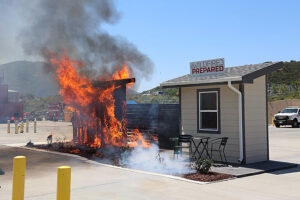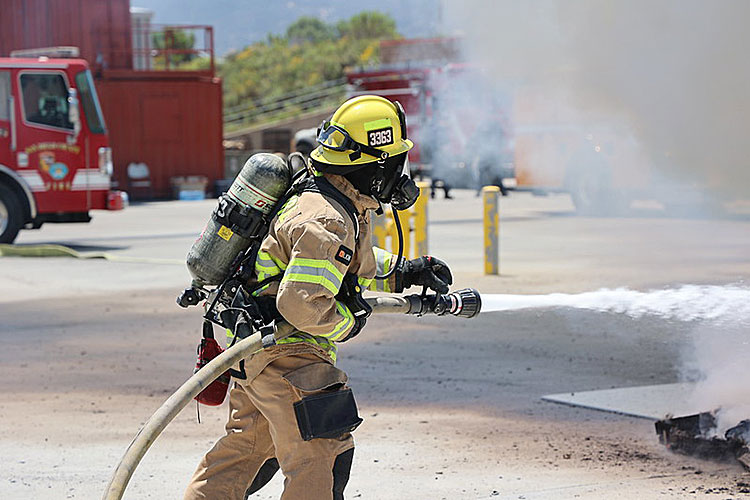Editor’s note: The following statement from the American Property Casualty Insurance Association is in response to the May 7 live burn demonstration by Cal Fire and the Insurance Institute for Business & Home Safety. This statement is attributed to Karen Collins, APCIA vice president, property & environmental.
•••
The January wind-driven wildfires in Los Angeles damaged or destroyed 18,298 structures and killed 30 people. These are the costliest wildfires in U.S. history. Wildfire risk is not going away. We must learn to live with wildfires and reduce the risk of embers igniting homes before the red flag warnings come again.
Individual property owner and community action are key to reducing losses and helping ease pressure on claims costs following increased natural disasters. The IBHS Wildfire Prepared Home™ framework serves as a vital program that provides homeowners with science-based tools to protect their homes, and attainment of the Wildfire Prepared Home™ designation may help homeowners improve their ability to obtain insurance.
 In an urban conflagration event, like what ravaged the Altadena & the Pacific Palisades communities during extreme wind conditions, fire fighters may not be able to defend your home. Your home must be ready to prevent ember ignition. Today Cal Fire and IBHS demonstrated critical steps that will increase the likelihood that a home survives for a family to return to. As more homes are hardened and more communities reduce risk, California should see a meaningful decrease in losses, which should positively impact the availability and affordability of insurance in the state. Insurers strongly support IBHS’ evidence-based Wildfire Prepared Home™ framework that was demonstrated in this live burn event today.
In an urban conflagration event, like what ravaged the Altadena & the Pacific Palisades communities during extreme wind conditions, fire fighters may not be able to defend your home. Your home must be ready to prevent ember ignition. Today Cal Fire and IBHS demonstrated critical steps that will increase the likelihood that a home survives for a family to return to. As more homes are hardened and more communities reduce risk, California should see a meaningful decrease in losses, which should positively impact the availability and affordability of insurance in the state. Insurers strongly support IBHS’ evidence-based Wildfire Prepared Home™ framework that was demonstrated in this live burn event today.
The cost to rebuild homes has increased 30 to 40 percent in the last five years. Record inflation, more homes built-in high-risk areas, increasingly severe and more frequent natural disasters fueled by climate change, and litigation abuse and fraud in the aftermath of these disasters, are putting extreme upward pressure on insurance costs. Insurance affordability and availability have a very real impact on families, individuals, business owners, and communities. That’s why insurers are fighting for solutions.
 Today’s live burn demonstration highlights the crucial steps homeowners can take to help reduce their risk of loss due to wildfire and help bend the loss curve down. As risk and costs continue to rise, Californians ask what we can do to protect our property? The answer is mitigation. To reduce a property’s wildfire risk, IBHS research shows homeowners can protect their homes through evidence-based home hardening and defensible space
Today’s live burn demonstration highlights the crucial steps homeowners can take to help reduce their risk of loss due to wildfire and help bend the loss curve down. As risk and costs continue to rise, Californians ask what we can do to protect our property? The answer is mitigation. To reduce a property’s wildfire risk, IBHS research shows homeowners can protect their homes through evidence-based home hardening and defensible space
techniques that focus on a critical 0–5-foot home ignition zone (also referred to as Zone 0, or noncombustible zone). When taken together, these actions can help reduce a home’s vulnerability to heat, flames, and embers that often may lead to total loss when a home ignites in a wildfire.
To live with wildfire and protect our properties we must break the pathways that may lead to ignition of the home, As California faces the threat of hotter and drier climate conditions, which may result in fires igniting more easily, spreading more rapidly, and burning more intensely, we all need to change our thinking, heed the advice of fire officials, and make mitigation a priority.
These simple steps to reduce risk in the landscaping around our home and reducing vulnerable entry points on our homes will help reduce the likelihood of ember ignition and prevent more losses. Communities must begin to adapt now, which should have a positive impact on California’s insurance market.
•••
The American Property Casualty Insurance Association is the primary national trade association for home, auto, and business insurers.



